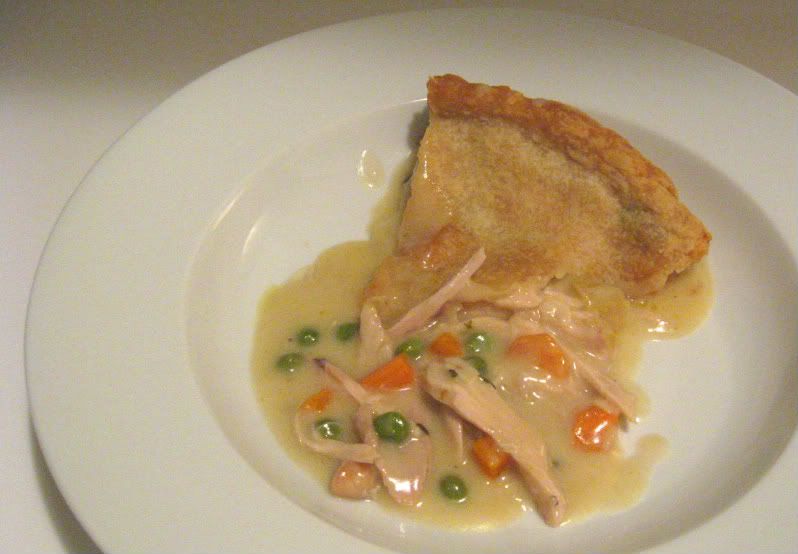I have a thing about uncooked dough and not at all in a normal way. Chocolate chip cookie dough, the darling of dough lovers everywhere, doesn't thrill me at all. No, I love unsweetened dough - yeast breads, rolled egg pasta, biscuits, and above all else, pie crust. As a child, I would hover 2 centimeters from my grandmother's elbow as she rolled out a crust, willing her to turn the rolling pin a few more times until the crust was just too large for the pie pan, silently cursing the little tears that required a spare scrap to mend. When the crust was properly crimped, I could go in for the kill, snagging the remnants. She'd put up with me for a bit, but eventually I'd get cut off. I'd make myself sick she'd explain. As an adult, I can attest to her wisdom. Without a parental figure monitoring my dough consumption, I do indeed make myself sick. Every time.
S. caught on to my dough habits early, and now, when he makes cinnamon rolls, he thoughtfully saves the ends. Unfortunately, he also thinks the best delivery method is to yell, "heads up, dough head" and send it hurtling across the room. I have never caught a flying object in my life. The skills of tracking the velocity and arc of an incoming projectile, coordinating my hands to arrive at the intercept of said projectile, and grasping on interception were not ones I acquired in my youth. As such, I am always smacked in the chest with the chunk of dough, and it lands ingloriously on the floor. Regrettably for my pride, I still retrieve it (and quite frankly, feel thrilled at my good fortune).
When I was growing up, my mother bought Pantry Pride white bread, a baked product not unlike Wonder Bread. The great thing about it was that I could nibble off the crust and then compact the remaining bread into a walnut-sized ball in my tiny fists. Without the air pockets, it was a reasonable stand-in for my real true love. I learned, not at a terribly advanced age, that Wonder Bread achieves its ethereal and non-nutritive texture by using a recipe that is so sloppy wet that it gets poured into the bread pans rather than kneaded and cradled. It makes me feel a little queasy thinking about it now, and it did at the time too, but I couldn't quite argue with the result.
It may be (although it probably isn't the case) that Wonder Bread evolved from a Colonial American (and before that, British) bread recipe called Sally Lunn. It's so old that nobody even knows why it's called that, although a number of non-credible and unbelievable explanations will be breathlessly repeated if you ask someone familiar with the recipe. I'll refrain from repeating them, but I will say that this dough pours. Sort of. It moves at the speed of molasses, although it also has strings of bread doughy gluten that make it look much less like molasses than actual molasses. After it's glopped into the bread pan to rise, it slowly settles into itself until the top of the bread is perfectly unblemished and smooth. Quite pretty really.
My apple guy in Indiana used to refer to some varieties as Tweaners. I'd say, "What's this [unknown apple variety]?", and then he's say: "Oh, that's a tweaner," which wasn't terribly illuminating until he explained that it's a term for apples that are between a sweet and tart apple - like Braeburns or Honeycrisps. Just my kind of apple as it turns out. Anyway, if tweaner were a term for bread, I think Sally Lunn would be one of them. It's somewhere between a sweet, rich and celebratory bread like Italy's Panetonne and a hearty staple bread. Faintly sweet and light enough to enjoy as a treat, but not so rich as to preclude eating it on a Tuesday in November. The crust is tender and thin, the crumb almost cakelike, and the flavor winking toward fats - egg yolk and butter. Nowadays, I'm far too grown-up to consider smashing its tender interiour into a little ball of dough, but if you're so inclined, I bet it would work perfectly.
As it turns out, it also works perfectly as a base for french toast. S. made a batch this weekend with plenty of eggs and milk so each slice was drowned in batter. They fried up brown and crisp on the edges, the interior tender and full of custard. That night, we finished the rest with a garlicy tomato broth, and while Sally Lunn was quite at home in both settings, she really prefers breakfast. See for yourself.
Sally Lunn
from American Cookery, James Beard
1 package active dry yeast
1/4 cup warm water
1 3/4 cups milk
2 tablespoons sugar
4 tablespoons butter
1 1/2 teaspoon salt
2 eggs, well beaten
5 cups flour, approximately
Dissolve the yeast in warm water. Heat the milk to almost boiling, and pour over the sugar, butter, and salt in the mixing bowl. Cool. Sift the flour and beat the eggs slightly. When the mixture has cooled, stir in the yeast, eggs, and 3 cups flour. Add enoguh additional flour to make a soft dough. Place the dough in a buttered bundt mold, or divide in half and place in a buttered 9x5x3 -inch loaf pans. Let rise till double in bulk. Bake at 400 degrees 15 minutes, then reduce to 350 for another 15-18 minutes.













































